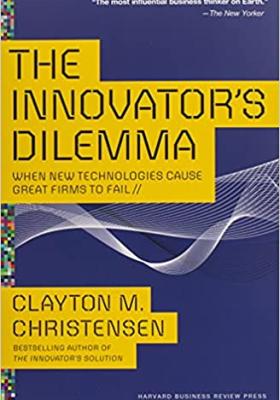
The Innovators Dilemma: When New Technologies Cause Good Firms To Fail
- By Clayton M. Christensen
- Publisher: Harvard Business Review Press
- Available in: English
- Total pages: 288
- ISBN: 9781633691780
- required for Authority
This book is about the failure of successful companies to stay atop their industries in the face of market and technological change. It proposes managerial solutions to address and harness these disruptive technologies.
The Innovators Dilemma: When New Technologies Cause Good Firms To Fail
- Part one: Why great companies can fail
- Chapter – 01: How Can Great Firms Fail? Insights from the Hard Disk Drive Industry;
- Chapter – 02: Value Networks and the Impetus to Innovate;
- Chapter – 03: Disruptive Technological Change in the Mechanical Excavator Industry;
- Chapter – 04: What Goes Up, Can’t Go Down;
- Part two: Managing disruptive technological change
- Chapter – 05: Give Responsibility for Disruptive Technologies to Organizations Whose Customers Need Them;
- Chapter – 06: Match the Size of the Organization to the Size of the Market;
- Chapter - 07: Discovering New and Emerging Markets;
- Chapter - 08: How to Appraise Your Organization’s Capabilities and Disabilities;
- Chapter - 09: Performance Provided, Market Demand, and the Product Life Cycle;
- Chapter - 10: Managing Disruptive Technological Change: A Case Study;
- Chapter – 11: The Dilemmas of Innovation: A Summary
This book is a core text for the APMG Professional Services Professional – Authority (Technical) certification, which is the world’s only non-vendor certification programme that develops the consultant of tomorrow. It provides key reading for the Foundation exam.
About the book:
The primary thesis of The Innovator’s Dilemma is that the management practices that allow companies to be leaders in mainstream markets are the same practices that cause them to miss the opportunities offered by disruptive technologies.
Part One describes both the processes through which disruptive technologies supplant older technologies and the powerful forces within well-managed companies that make them unlikely to develop those technologies themselves.
Part Two offers a framework, based on four Principles of Disruptive Technology, to explain why the management practices that are the best for exploiting existing technologies, are anti-productive when it comes to developing disruptive ones. He suggests ways that managers can harness these principles, so that their companies can develop the new technologies that are going to capture their markets in the future.
Key features:
- Equips managers with the knowledge and four key principles to understand disruptive technology.
- Draws from a range of illuminating case studies showing how companies should not wait for new breakthroughs to improve a technology’s performance.
- Provides an approach that will enable managers to respond effectively to the opportunities that disruptive technology presents.






